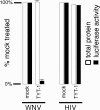Sultam thiourea inhibition of West Nile virus
- PMID: 17452483
- PMCID: PMC1913232
- DOI: 10.1128/AAC.00007-07
Sultam thiourea inhibition of West Nile virus
Abstract
We have identified sultam thioureas as novel inhibitors of West Nile virus (WNV) replication. One such compound inhibited WNV, with a 50% effective concentration of 0.7 microM, and reduced reporter expression from cells that harbored a WNV-based replicon. Our results demonstrate that sultam thioureas can block a postentry, preassembly step of WNV replication.
Figures





Similar articles
-
Discovery of small molecule inhibitors of West Nile virus using a high-throughput sub-genomic replicon screen.Antiviral Res. 2006 Jun;70(2):39-50. doi: 10.1016/j.antiviral.2006.01.005. Antiviral Res. 2006. PMID: 16724398
-
Identification and biochemical characterization of small-molecule inhibitors of west nile virus serine protease by a high-throughput screen.Antimicrob Agents Chemother. 2008 Sep;52(9):3385-93. doi: 10.1128/AAC.01508-07. Epub 2008 Jul 7. Antimicrob Agents Chemother. 2008. PMID: 18606844 Free PMC article.
-
Identification and characterization of inhibitors of West Nile virus.Antiviral Res. 2009 Jul;83(1):71-9. doi: 10.1016/j.antiviral.2009.03.005. Epub 2009 Apr 1. Antiviral Res. 2009. PMID: 19501258 Free PMC article.
-
Genetic systems of West Nile virus and their potential applications.Curr Opin Investig Drugs. 2003 Aug;4(8):959-65. Curr Opin Investig Drugs. 2003. PMID: 14508880 Review.
-
West Nile virus drug discovery.Viruses. 2013 Dec 3;5(12):2977-3006. doi: 10.3390/v5122977. Viruses. 2013. PMID: 24300672 Free PMC article. Review.
Cited by
-
Molecular targets for flavivirus drug discovery.Antiviral Res. 2009 Jan;81(1):6-15. doi: 10.1016/j.antiviral.2008.08.004. Epub 2008 Sep 15. Antiviral Res. 2009. PMID: 18796313 Free PMC article. Review.
-
Unveiling sultam in drug discovery: spotlight on the underexplored scaffold.RSC Med Chem. 2024 Apr 16;15(6):1798-1827. doi: 10.1039/d3md00653k. eCollection 2024 Jun 19. RSC Med Chem. 2024. PMID: 38911171 Free PMC article. Review.
-
Design, synthesis, and in vitro evaluation of potential West Nile virus protease inhibitors based on the 1-oxo-1,2,3,4-tetrahydroisoquinoline and 1-oxo-1,2-dihydroisoquinoline scaffolds.J Comb Chem. 2010 Nov 8;12(6):836-43. doi: 10.1021/cc100091h. Epub 2010 Sep 30. J Comb Chem. 2010. PMID: 20882963 Free PMC article.
References
-
- Abbenante, G., and D. Fairlie. 2005. Protease inhibitors in the clinic. Med. Chem. 171-104. - PubMed
-
- Anonymous. 2003. Tricyclic lactam and sultam derivatives as histone deacetylase inhibitors. Expert Opin. Ther. Pat. 13387-391.
-
- Arvidson, B., J. Seeds, M. Webb, L. Finlay, and E. Barklis. 2003. Analysis of the retrovirus capsid interdomain linker region. Virology 308166-177. - PubMed
-
- Baker, D. C., and B. Jiang. March 2002. Sultams: solid phase and other synthesis of anti-HIV compounds and compositions. U.S. patent 6,353,112 B1.
Publication types
MeSH terms
Substances
Grants and funding
LinkOut - more resources
Full Text Sources
Other Literature Sources

